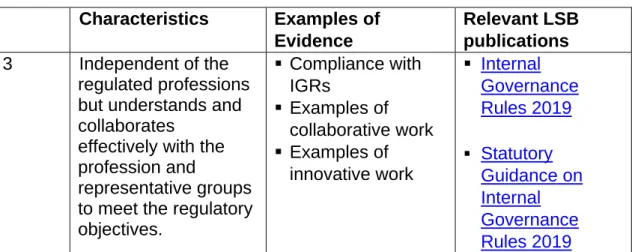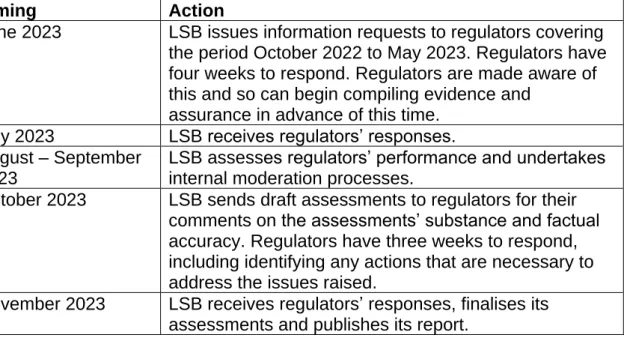In doing so, one of our core functions is to oversee the regulators' performance under the regulatory performance assessment framework, which currently consists of standards and outcomes that we expect regulators to meet to demonstrate that they are effective regulators. Other areas for improvement include reviewing how we assess and present our assessments of regulators' performance so that they are more informative to the public and other interested stakeholders;. This consultation seeks views on our proposals for a revised framework against which we will assess regulators' performance.
This includes proposed standards and attributes (the attributes of effective regulators, e.g. knowledge, processes), which are intended to be supported by a resource book that provides additional information to help regulators demonstrate how they are complying with the standards. This includes greater emphasis on the regulatory objectives and strategic leadership of the. Other areas for improvement include reviewing the way we assess and present our assessments of regulators' performance and making better use of data.
In developing the proposed framework, we mapped existing standards and outcomes with the regulatory objectives, better regulation principles and regulatory regimes set out in the law. Each of the proposed standards is supported by a set of features that we expect regulators to demonstrate to provide assurance that they are well-led and effective in their approach to and implementation of regulation for the public.
Well led
Effective approach to regulation
Operational delivery
Do you agree that the proposed attributes that support the standards are reasonable expectations of the skills and processes that an effective regulator will possess. We have found the targeted reviews of the BSB and FO's respective performance against the current Good Conduct standard to be highly effective in helping us to understand the regulators' practices and to identify the root causes of the performance issues. Option a: undertake the 2022 evaluation against the current framework and postpone any implementation of the proposed framework until 2023.
Option b: do not carry out an assessment in 2022 and postpone the implementation of the proposed framework until 2023. We also believe that it would not be optimal to postpone the implementation of the proposed framework until 2023 (options a and b). Due to the delay, it would be some time before we see the benefits of the revised approach.
Instead, we propose to adopt option c, the hybrid approach, which would provide a useful opportunity for both the LSB and regulators to gain experience with the revised assessment approach prior to the introduction of the standards and features of proposed in 2023. We have considered whether the first Assessment under the proposed framework should cover the performance of regulators against the three proposed standards. We propose that in future years, we will not necessarily require assurance of regulators' performance against all three standards on an annual basis.
We have given due consideration to our obligations under the Equality Act 2010, including the public sector's duty of equality.64F 10. We have assessed the likely impact of the proposed framework on regulators, their regulated communities, consumers and the wider public considered. For example, well-run regulators would already take regulatory objectives into account when defining their work programs and this should be reflected in the materials provided to their boards.
One of the stated aims of this work is to encourage regulators and their boards to take ownership of all regulatory objectives in the performance of their regulatory functions. We have taken into account the principles of better regulation in developing the proposals. We consider that the revised framework will be a proportionate, transparent, accountable, consistent, targeted and effective tool to ensure the performance of regulators in meeting regulatory objectives.
We welcome comments on the potential impact of the revised framework and any quantification of likely costs and expected benefits to further inform our assessment of the regulatory impact of the proposed revisions. Do you have any comments on the potential impact of the proposed framework, including likely costs and expected benefits?

Well-led
For the public, with the professions: Framework for effective regulation in the legal services sector. 3 Independent of the regulated professions, but understands and works effectively with the profession and representative groups to achieve the regulatory objectives. Evaluating the impact of regulator's work in addressing concerns raised by and issues facing the public.
Regulators act on behalf of the public to apply their knowledge to identify opportunities and address risks to meet regulatory objectives. 10 Engages proactively and meaningfully with a wide range of interested stakeholders, including the public, consumers and regulated communities to inform decisions. Stakeholder Feedback 11 Understands the range of formal (eg rules) and informal (eg influence) regulatory levers at one's disposal and how to best utilize them.
12 Obtains and effectively uses data, including making it available to others, to inform how it meets regulatory objectives. 14 Committed to improving the diversity of the profession at all levels and taking action to remove barriers to inclusion. 15 Committed to improving access to services for the public and consumers in all their diversity.
Regulators' operational activity (eg education and training, authorisation, supervision, enforcement) is effective and clearly focused on the public interest. Consumer-oriented information about the contents of the register and what it means to be on it. Evidence of how activity is focused on the public interest and the needs of vulnerable members of the public.
DRAFT
Regulatory performance assessment framework
We ensure that the regulation of legal services is carried out independently of the organizations representing providers. 16 The professional principles, included in Article 1, third paragraph, of the Act. https://www.legislation.gov.uk/ukpga/2007/29/section/1), are: (a) that authorized persons must act with independence and integrity, (b) that authorized persons must maintain appropriate standards of work , ( c) that authorized persons should act in the best interests of their clients, (d) that persons exercising a right of hearing or litigation before a court in connection with proceedings before a court, on the grounds that they are authorized persons must comply with their duty to the court to act independently in the interests of justice, and (e) that clients' matters must be treated confidentially. We take into account the need to be proportionate and targeted in our use of our powers to ensure that regulators act effectively for the benefit of consumers and the wider public.
Our assessment of the performance of supervisory authorities is central to our role as a supervisory authority. The effective approach to the regulatory standard requires regulators to act on behalf of the public to use their knowledge to identify. 3 Independent of the regulated professions, but understands and works effectively with the profession and representative groups to accommodate.
9 Has a comprehensive understanding of the market it regulates, including the consumers of services, and proactively identifies risks to regulatory objectives; has a clear program of activities to address those risks. 13. Our approach to assessing regulators' performance against standards and supporting features is evidence-based. That the evidence shows that the regulator has taken regulatory objectives and better regulation principles into account when making decisions.
To support regulators and develop a common understanding of what information can be provided as security, we have presented examples of the types of evidence that can be provided in an illustrative, non-exhaustive list in the sourcebook. We may make proportionate and targeted requests for information to gain assurance about the performance of regulators. However, if we need more information, we may use our formal information gathering powers under section 55 of the Act to obtain it. 19.
Our assessment approach typically includes ongoing monitoring of regulator performance and an annual regulator assessment. It also allows us to identify any thematic issues that have arisen for some, or all, regulators and that need to be addressed. This can be a targeted review of a regulator's performance against one or more standards20.
After this meeting, we will confirm the scope of the review with the regulator. We will consider any comments from the regulator on our draft report and make any changes we believe are necessary before publishing the final report on our website.
